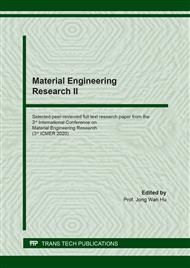[1]
H. Meng, J. Hu, A brief review of stimulus-active polymers responsive to thermal, light, magnetic, electric, and water/solvent stimuli, J. Mater. Syst. Strut. 21 (2010) 859-885.
DOI: 10.1177/1045389x10369718
Google Scholar
[2]
J. Dragan, A. Tourrette, P. K. Lavric, Biopolymer-based stimuli-responsive polymeric systems for functional finishing of textiles, J. Biopolym. 45 (2009) 37-40.
DOI: 10.5772/10257
Google Scholar
[3]
K. Akamol, C. Nagamani, S. Thayumanavan, Multi-stimuli sensitive amphiphilic block copolymer assemblies, J. Am. Chem. Soc. 131 (2009) 4830-4838.
DOI: 10.1021/ja809475a
Google Scholar
[4]
L. J. Francois, Polymerization of oligo (ethylene glycol) (meth) acrylates: toward new generations of smart biocompatible materials, J. Polym. Sci. Part A: Polym. Chem. 46 (2008) 3459-3470.
DOI: 10.1002/pola.22706
Google Scholar
[5]
J. T. Wang, Y. C. Chiu, H. S. Sun, et al., Synthesis of multifunctional poly (1-pyrenemethyl methacrylate)-b-poly (N-isopropylacrylamide)-b-poly (N-methylolacrylamide) s and their electrospun nanofibers for metal ion sensory applications, J. Polym. Chem. 6 (2015) 2327-2336.
DOI: 10.1039/c4py01773k
Google Scholar
[6]
A. Geissler, F. Loyal, M. Biesalski, et al., Thermo-responsive superhydro-phobic paper using nanostructured cellulose stearoyl ester, Cellulose, 21 (2014) 357-366.
DOI: 10.1007/s10570-013-0160-8
Google Scholar
[7]
C. Azra, D. Alhzov, E. Zussman, Effect of polymer nanofibers thermoelasticity on deformable fluid-saturated porous membrane, J. Polym. 58 (2015) 162-169.
DOI: 10.1016/j.polymer.2014.12.062
Google Scholar
[8]
P. Glampedaki, A. Calvimontes, V. Dutschk, et al., Polyester textile functionalization through incorporation of pH/thermo-responsive microgels. Part II: polyester functionalization and characterization, J. Mater. Sci. 47 (2012) 2078-2087.
DOI: 10.1007/s10853-011-6006-6
Google Scholar
[9]
H. Zhou, R. Xun, Q. Liu, et al., Preparation of Thermal and pH Dually Sensitive Polyurethane Membranes and Their Properties, J. Macromole. Sci. Part B, 53 (2014) 398-411.
DOI: 10.1080/00222348.2013.845059
Google Scholar
[10]
Q. Zhong, Y. Y. Chen, S. L. Guan, et al., Smart cleaning cotton fabrics cross-linked with thermo-responsive and flexible poly (2-(2-methoxyethoxy) ethoxyethyl methacrylate-co-ethylene glycol methacrylate), J. RSC Adv. 5 (2015) 38382-38390.
DOI: 10.1039/c5ra03256c
Google Scholar
[11]
Y. Ye, J. Huang, X. Wang, Fabrication of a Self-Cleaning Surface via the Thermo-Sensitive Copolymer Brush of P(NIPAAm-PEGMA), J. ACS Appl. Mater. Interf. 7 (2015) 22128-22136.
DOI: 10.1021/acsami.5b07336
Google Scholar
[12]
T. Saitoh, K. Asano, M. Hiraide, Polyallylamine-conjugated thermo-responsive polymers for the rapid removal of phenolic compounds from water, J. React. Function. Polym. 72 (2012) 317-322.
DOI: 10.1016/j.reactfunctpolym.2012.03.006
Google Scholar
[13]
Y. Cao, N. Liu, C. Fu, et al., Thermo and pH dual-responsive materials for controllable oil/water separation, J. ACS Appl. Mater. Interf. 6 (2014)) 2026-2030.
DOI: 10.1021/am405089m
Google Scholar
[14]
J. Wu, Y. Jiang, D. Jiang, et al., The fabrication of pH-responsive polymeric layer with switchable surface wettability on cotton fabric for oil/water separation, J. Mater. Lett. 160 (2015) 384-387.
DOI: 10.1016/j.matlet.2015.07.146
Google Scholar
[15]
V. Aseyev, H. Tenhu, F. M. Winnik, Non-ionic thermoresponsive polymers in wate. Self-Organized Nanostructures of Amphiphilic Block Copolymers II. Springer, Berlin, 2010, pp.29-89.
DOI: 10.1007/12_2010_57
Google Scholar
[16]
J. F. Lutz, K. Weichenhan, O. Akdemir, et al., About the phase transitions in aqueous solutions of thermoresponsive copolymers and hydrogels based on 2-(2-methoxyethoxy) ethyl methacrylate and oligo (ethylene glycol) methacrylate, J. Macromolecules. 40 (2007) 2503-2508.
DOI: 10.1021/ma062925q
Google Scholar
[17]
Q. Zhong Q, C. Chen, L. Mi, et al., Thermoresponsive diblock copolymer films with a linear shrinkage behavior and its potential application in temperature sensors. J. Langmuir. 36 (2020) 742-753.
DOI: 10.1021/acs.langmuir.9b03462
Google Scholar
[18]
Q. Zhong, W. Wang, J. Adelsberger, et al., Collapse transition in thin films of poly (methoxydiethylenglycol acrylate, J. Colloid Polym. Sci. 289 (2011) 569-581.
DOI: 10.1007/s00396-011-2384-1
Google Scholar


